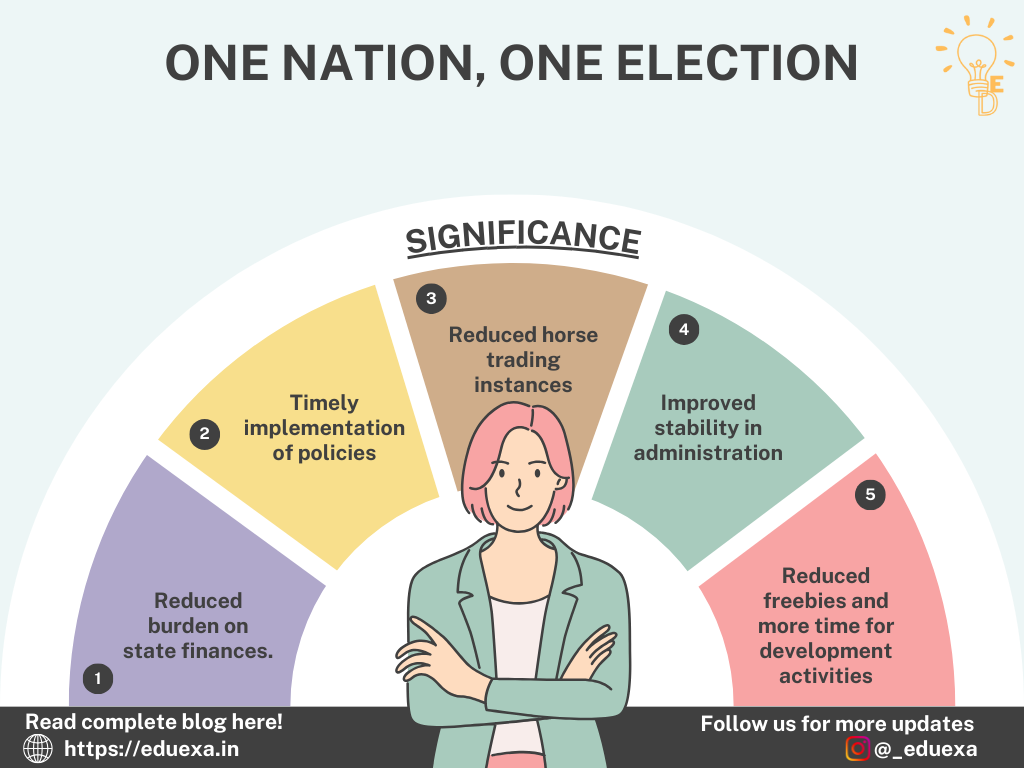One Nation One Election
Question: Critically evaluate the need of conducting simultaneous elections to Lok Sabha and state Legislative Assembly.
Recent talks concerning “one nation, one election” has resulted in formation of a committee headed by Ram Nath Kovind to Study its feasibility and synchronise elections for both loksabha and state legislative assemblies.
Problems associated with current election pattern
- Model code of conduct and governance time out leads to policy paralysis.
- Elections are costly affair in India and put a heavy burden on state machinery and state exchequer.
- More chances for electoral corruption and less voter turnout.
- Horse trading and defection cases
Significance of simultaneous Elections
Reduced costs
Having simultaneous elections would result in utilisation of all the polling expenditure, infrastructure and other resources on the same day resulting in reduced costs which are being born in case of present election.
Improves stability
Having simultaneous elections would result in more stability in administration as all the members of legislative assemblies and all MPs would serve the same tenure. Persistent problem of elections being held in different states at different time would be addressed.
Timely implementation of policies
Due to more time devoted to development activities rather than electioneering, implementation of policies would be more effective.
Reduced freebies
Simultaneous election would result in less distribution of freebies and instead working for better policy administration.
Reduced constraints on state finances
Frequent elections put great burden on state exchequer and resources. With Simultaneous election, state’s burden can be reduced to a significant amount.
Less instances of horse trading
Frequent elections results in more horse trading and defection cases. Holding simultaneous election at a fixed period will make it difficult for the members to switch parties.
Drawbacks
Feasibility concerns
Indian constitution provides for 5 year term and in case of any dissolution or emergency the simultaneous election schedule may hamper this tenure security.
Amendment of constitution
One nation, one election would demand constitutional amendment which itself is a lengthy and difficult process.
Procedural complications
Simultaneous elections would also demand a proper amendment in People’s representative act, rules and procedures of business and model code of conduct.
Affects federalism
Simultaneous election idea does not Square with notion of federalism enshrined in the constitution.
Infrastructure and human resources
Simultaneous election would also demand proper polling stations, VVPAT, other equipment and officers at same time which is very difficult to arrange.
Voter’s attitude
Having simultaneous elections has the potential risk of less voter turnout and voting on parochial factors.
Way Forward
Build consensus
All the states’ opinions and suggestions should be taken into consideration for better implementation of simultaneous elections.
Establishing committee
Committees and framework should be formed in order to deal with any incumbency, emergency, failure of government machinery.
Building Infrastructure
Infrastructure and human resources should be managed efficiently to visualise one nation, one election as reality.
Amending the constitution
To address no confidence motions and also to align the electoral cycles of all the state legislative assemblies.
Conclusion
Consensus based decision making regarding applicability of Simultaneous election is necessary to ensure feasibility of election along with avoidance of any injury to federalism.



Pingback: How to Choose UPSC Optional Subjects: A Comprehensive Guide in 2024
really insightful! thanks
Pingback: Complete Guide on India Oman Relations UPSC - Eduexa
Pingback: Areas of conflict between India and Pakistan- Eduexa
Pingback: Preamble of Indian Constitution | Preamble of India - Eduexa